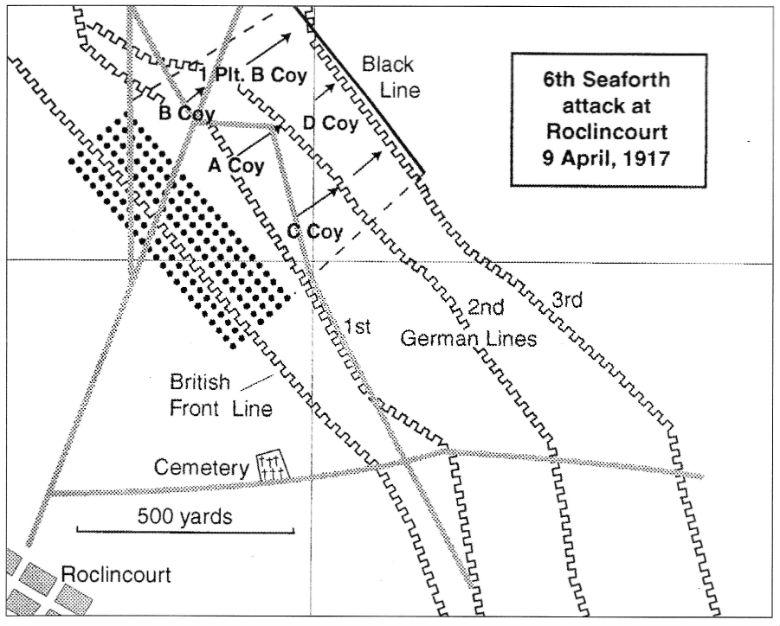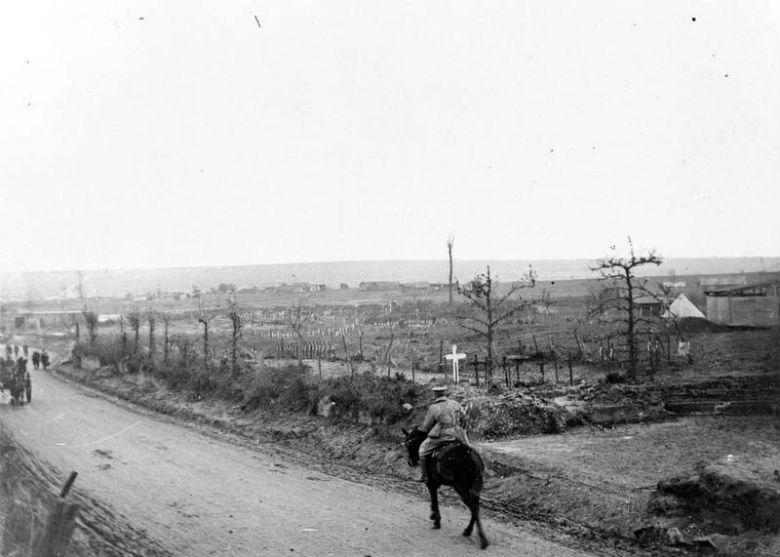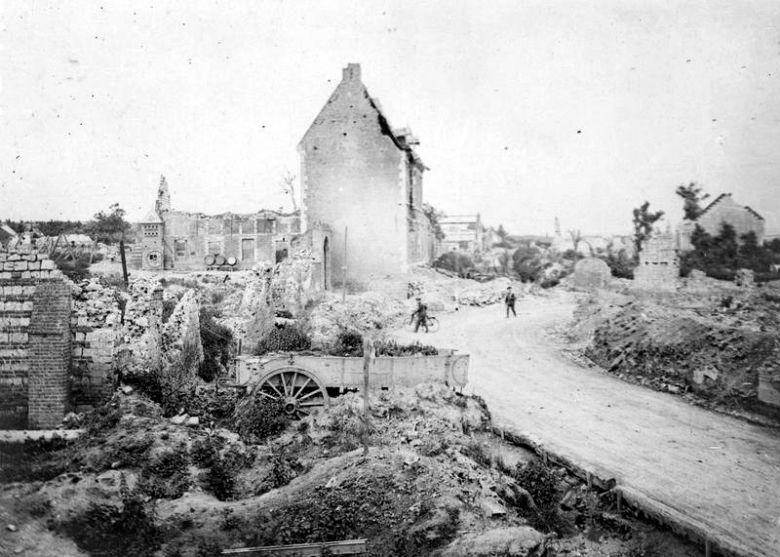6th Seaforth Attack nr. Roclincourt, Battle of Arras
9th/10th April 1917
This extract from "The Spirit of the troops is Excellent" is reproduced with the kind permission of the Author Derek Bird. Nivelle, referred to in the first sentence, was the French commander. The Arras offensive was planned in conjunction with the French High Command, who were simultaneously embarking on a massive attack (the Nivelle Offensive) about eighty kilometres to the south.

6th Seaforth, Roclincourt, Arras
show infoDescription:
Sketch map detailing trench positions and attack lines during the 6th Seaforth's attack at Roclincourt, Arras on the night of the 9th April 1917 as part of the Nivelle Offensive.
Tags:
Arras 9/10 April 1917
“The British part of the Nivelle offensive was for an advance on a front of 14 miles by 17 division, with three more in reserve, with their furthest objectives up to four mile beyond the German front line. The Highland Division was allocated a front of some 3,000 yards that faced north at the Labyrinth on the southern flank of Vimy Ridge, and then swung south-east as it ran to the east of Roclincourt. The 154th Brigade was on the left of the division's front and had a very difficult manoeuvre to perform in changing direction to join up with the 1st Canadian Division sweeping eastwards from its own positions on Vimy Ridge. The 152nd Brigade was on the right of the divisional front, with 153rd Brigade in reserve. The first objective was called the 'Black Line', the second the 'Blue Line' and the third the 'Brown Line'. There was also a 'Green Line' that was to be attacked if the earlier stages of the advance were successful. On the 152nd Brigade's front there were three lines of trenches to overcome between the British front line and the 'Black Line'. The capture of the ground up to the 'Black Line' was given to the 6th Seaforth, with the 1/5th Seaforth then passing through them to continue the advance.
The preparatory barrage for the attack started in earnest on 4 April when wire cutting by light artillery and 2-inch trench mortars was intensified. Heavier artillery was used to destroy German gun positions, trenches and strong points. Livens Projectors and Stokes Mortars (of which some 100 of the former and 8 of the latter were available on the divisional front) were also used to fire gas at the Germans on the 4th, 5th and 8th.
(Designed by Lt William Liven who had served with 186 Special Company, Royal Engineers, since the first days of British gas warfare, his projector was a form of mortar that fired 8-inch (200mm) diameter projectiles. Each projectile was filled with about 30 pounds (13.5 kg) of liquid gas, or oil that was ignited on impact, and had a range of up to 1,500 yards. Batteries of projectors were normally dug into the ground behind the British front line and were electrically fired in salvos to deliver gas or burning oil into the enemy lines.)

Cemetery, Roclincourt
show infoDescription:
IWM Photo of Cemetery nr. Roclincourt. Taken on 31 Oct 1917.
Copyright:
IWM Q70724
Tags:
Let us now return to the story of the 6th Seaforth as they prepared for their part in the forthcoming battle. Following a morning church parade on I April 'B' and 'D' Companies marched to Acq to attend a parade at which the GOC XVII Corp presented awards. On the following day the battalion moved into the huts at Ecoivres where their preparations continued.
On the 7th 'A' and 'C' Companies, plus Battalion HQ, moved forward to take up positions in the trenches east of Roclincourt, while 'D' Company remained at Ecoivres, and 'B' Company moved into cellars at Anzin. The Germans laid down an artillery and machine-gun barrage on the area, probably because of suspicions about the forthcoming attack, and the battalion was lucky to have only a small number of men wounded.
On the night of the 8th both 'B' and 'D' Companies moved forward and took up positions in the assembly trenches. By 3.30 a.m. on the 9th everyone was in position and a very welcome tot of rum and drinks of hot Oxo were served to the men while they waited for zero hour.
Following the success at Beaumont Hamel a similar system would be used in the attack at Roclincourt. The battalion would advance in a series of double waves. Each double wave would combine when they reached the German lines. Each of the three trenches to be attacked was allocated to part of the battalion. Once a line had been captured the following waves would pass through to continue the advance.
The orders for the attack included comprehensive instructions on the clothing to be worn, equipment and weapons to be carried, the position of dump and much more. At 5.25 a.m. the order to fix bayonets was passed along the line, and the men steeled themselves for what was to come as the final anxious moments passed before going 'over the top'. At exactly 5.30 a.m. the British bombardment intensified to a crescendo as every artillery piece fired onto the German positions and machine-guns joined in the barrage. Meanwhile the first waves of attackers clambered out of their trenches. The barrage, although reported not to be as heavy as at Beaumont Hamel, was very accurate and the leading wave was able to close up behind its protection. On the right and centre the men were as close as 10 yards, and on the left within 15 to 20 yards of the protective curtain of British shells. The barbed wire had been well cut and did not pose any significant obstacle so, at 5.34 a.m. when the barrage lifted off the first German line, the 6th Seaforth rushed forward and took up firing positions on the edge of the trench. Initially they made no attempt to jump into the trenches because they had learnt that the Germans were likely to rush out of their dug-outs and start firing along the trench, which in the past had caused many casualties. By staying on the parapet the Highlanders were reasonably protected from any fire from the trench itself and they could shoot the enemy down as they emerged from their dug-out. Once the enemy been satisfactorily dealt with the Highlanders could then climb down into the trenches.
All went well on the left and in the centre with 'B' and 'A' companies reaching the first German line with few casualties, and they immediately started to consolidate the newly won positions. However on the right in 'C' Company's sector a number of Germans had got out from their trench, sought cover in shell holes to the rear, and started sniping at the Highlanders working on reversing the trench and at those still advancing in the later waves. A number of casualties were sustained before the snipers were hunted down and killed. It was also reported that a German officer initially put up his hand to surrender but then killed two men - he was shown no mercy and was quickly despatched.
The third and fourth waves of Seaforths passed through the German first line and continued towards their objective, the German second line. Once again good progress was made on the left and the centre. Contact was made with the 1/9th Royal Scots advancing on their northern flank, but by now there was much heavier German machine-gun and rifle fire all along the line and the Highlanders were sustaining many casualties. The right of the battalion's advance was particularly affected by very heavy fire from an enemy communication trench and positions in the open. Parties were detailed to deal with these position and with skill and daring they killed a machine-gun team and captured their gun, and also dealt with a number of snipers. After just twenty minutes the 6th Seaforth had completed the capture of the second line. In a letter to his mother written a few days later Private William Mackay said:
"We made a very successful advance early on Monday morning. Our artillery made very good work. We drove them back a long way. Our platoon along with another platoon took the second line. I suppose you will get the full report in the papers by now. It was a very exciting time it was my first experience of 'Over the bags' as we call it. Our platoon was very lucky we had very few casualties; we lost our Platoon officer and we miss him very much."
(William Mackay, from Duress, Sutherland, was serving in No. 12 Platoon, 'C' Company. He was killed on 16 May 1917, just a month after writing home describing his first attack. Having no known grave he is commemorated on the Arras Memorial to the Missing.)
The final two waves, consisting of one platoon of 'B' Company on the left and the whole of 'D' Company, had set off at the same time as the waves in front, but had started from positions some distance further back. Just after leaving the assembly trench a shell landed among the men on the right causing 15 casualties. The survivors made their way to the newly captured German second line without too much difficulty, but as soon as they tried to advance to their own objective, the 'Black Line' (the German third line), the left and centre was quickly brought to a halt by machine-gun and sniper fire. A party in the centre under the command of Second Lieutenant James Spence managed to make its way forward along a trench and arrived in the German third line some thirty-four minutes into the attack. Just after the right hand part of the battalion had caught up with Spence' party the Germans detonated a small mine a short distance behind the third line. This inflicted more casualties upon themselves than to the advancing Highlanders. Despite small groups of 6th Seaforth first entering the third line soon after 6 a.m. it took another three hours of determined and difficult fighting to overcome the final resistance. On the right all the officers had been killed or wounded and it was left to the COs to lead the men forward. On the left the battalion suffered many casualties before Second Lieutenant C.L. Read collected together surviving men of his own battalion and some from the 1/7th Argyll also in his vicinity. He then led his makeshift platoon in a flanking movement that managed to silence the machine-gun that had been one of the main causes of the hold up. Once the various small parties had arrived at the 'Black Line' they started to work sideway along the trench to make contact with each other, and also to join up with the neighbouring battalions on their flank.

Roclincourt in ruins
show infoDescription:
Photo depicting the ruins of Roclincourt, north of Arras. Taken 30 May 1917.
Copyright:
IWM Q69006
Tags:
With the Morayshire battalion in possession of their objectives they could, once the 1/5th Seaforth had passed through them, turn their efforts to consolidating the captured German trenches . The battle itself was still far from over, with the 'Blue Line' not being secured by the 1/5th Seaforth until mid-afternoon. That battalion then continued the advance until they came to the strongly defended Elect Trench about half way between the 'Blue' and 'Brown Lines'. Following reports that the 154th Brigade had reached the 'Brown Line', a further attack by 152nd Brigade and their neighbours to the south, the 103rd Brigade, was planned.
This was carried out at 5 a.m. on 10 April and was a success, however, it transpired that the reports from the 154th Brigade had been incorrect and they had not advanced as far forward as the 'Brown Line'. All attempts to rectify this error were beaten off by machine-gun fire. By this time the weather had conspired against the attackers and, with snow having fallen and settled on the ground, movement across the battlefield in daylight became very obvious. It was decided to try again on the night of the 11 - 12th with the support of an artillery barrage and a tank, but reports started to come in indicating that the section of 'Brown Line' in front of 154th Brigade was now empty. Patrols confirmed that the German had indeed abandoned their positions, enabling the rest of the 'Brown Line' to be occupied without opposition. During these later phases of the battle the 6th Seaforth assisted the forward battalions by providing carrying parties to take supplies up to the 'Brown Line'. They were also able to recover the bodies of many of the dead for burial.
Casualties were heavy and the battalion War Diary stated that 142 were killed, 176 wounded and 2 missing, With so many dead almost every community in Morayshire suffered the loss of one or more of its men; the small community of Hopeman suffering particularly with the loss of Robert and William McPherson, and George Stronach.'
In the footnote the detailed casualties are recorded “Comprising 4 officers and 106 men killed on 9 April, one man killed on the 10th, and 31 dying of wounds in the period 9 - 17 April. Most those killed were buried close to the battlefield with 95 in the Highland Cemetery, Roclincourt, and 9 in the nearby Roclincourt Military and Roclincourt Valley Cemeteries. The bodies of the officers, Captain Gerald Stewart, and 2/Lts Law, Edwin Middleton and Charles Webster were taken back to Marcoeuil for burial.
Division History References :
The 51st Highland Division in the Battle of Arras during the First World War, April 1917
